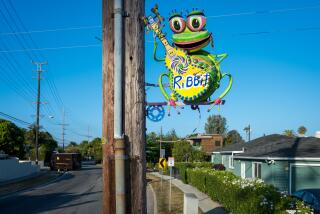CCDC Makes Light of Its Low-Sodium Diet
- Share via
The Centre City Development Corp. may have lost the war to keep low-pressure sodium lighting out of downtown, but the battle of words over the amber-colored street lights continues.
Last year, the council voted to install the low-sodium lights throughout the city after astronomers from nearby observatories complained that light pollution from the existing street lights was hampering their research.
Concerned that the yellowish low-pressure sodium lights, branded “bug lights” by opponents, might put downtown in the wrong aesthetic light, CCDC asked the City Council early this year to exempt San Diego’s redevelopment area from the new street lighting program.
The council, however, rejected the redevelopment agency’s request, citing economic factors--the low-sodium lights use less than half the electricity that mercury vapor street lights use. The council also said it was reluctant to show favoritism to any area over placement of the lights.
One of the major complaints about low-sodium lighting is that it produces poor color rendition, causing most objects, regardless of their color, to appear to be a shade of gray. CCDC officials, noting that image can be as important as reality, contend that the yellowish lights might make some people less inclined to walk around downtown at night than they would be if the streets were illuminated by “normal” lighting.
Still licking their wounds over the subject, CCDC officials cast the issue in a humorous light during a recent discussion over plans to install brightly colored street banners on downtown utility poles in preparation for the planned August opening of the $140-million Horton Plaza retail and entertainment center.
The banners, intended not only to create a festive air in celebration of the Horton Plaza project’s opening but also to help guide people unfamiliar with downtown to the 6 1/2-block development, feature lively colors such as lavender, bright yellow, dark purple and turquoise.
However, Max Schmidt, CCDC’s assistant vice president for planning and engineering, jokingly presented the agency’s board of directors with a sketch of what the banners might look like at night under the low-sodium lights. In the sketch, all of the banners appeared light or dark gray.
Discover San Marcos
Tired of the same old crowd at St. Tropez? You say Maui’s getting a little too touristy for your taste? Then, why not vacation in beautiful San Marcos this summer?
While San Marcos is not widely recognized as a tourist mecca, Mayor Lionel G. Burton has proclaimed next week as “San Marcos Tourism Week.” According to Burton’s proclamation, tourism “promotes intercultural understanding and appreciation of the geography, history and people of San Marcos.”
Imagine the possibilities. Snapshots of the family in front of the proposed trash-to-energy plant site! A visit to the Prohoroff Poultry Farm! And just think how envious your friends will be when you send them a postcard from San Marcos, the “Valley of Discovery.”
Banner Idea Still Unfurling
In December, special education students at Jefferson Junior High School in Oceanside wrote letters to the governors of all 50 states requesting a state flag to be placed along a planned “Walkway of States” at the school.
Nearly six months later, the learning-disabled students have received only six flags--those of New Jersey, Alabama, West Virginia, Illinois, Wisconsin and Wyoming--and are feeling “a little discouraged but not defeated,” according to Carole Wimpress, one of three teachers assisting with the project. The other teachers involved are Norma Sanders and Ron Losh. Shirley Downey, Wimpress’ aide, also has helped.
“We really expected more of a positive response,” Wimpress said. “It took quite a bit for some of these students to write these letters.”
Wimpress said that officials from most states wrote back saying that fiscal constraints made it impossible for them to give away the flags, but that the banners could be purchased for prices ranging from $15 to $55. Some states, however, did not even bother to respond, Wimpress said. California, incidentally, “turned us down flat,” she said.
Hoping to rejuvenate their flagging project, the students plan to write to congressmen seeking assistance. “We also hope that we can find people who perhaps know a governor and might be able to help us,” Wimpress said.
“This just means the project is going to take longer than we thought,” Wimpress said. “We’ll stick with it for two, three years, however long it takes.”
Ben Would Get a Jolt
Benjamin Franklin would be shocked by a recent edition of the San Diego Gas & Electric Co.’s “Energy Notes.”
“Energy Notes,” a small flyer featuring energy saving and safety tips that is mailed out to SDG&E; customers along with their monthly bills, offered this advice about kite flying:
“The kite (should be) flown far away from power lines. Another precaution is to make sure there’s no metal in your kite or its string. And never fly a kite in the rain.”
If Franklin had followed that advice, you might be reading this by candlelight. And if that were the case, there might not be an SDG&E.;
Hmmm.
More to Read
Sign up for Essential California
The most important California stories and recommendations in your inbox every morning.
You may occasionally receive promotional content from the Los Angeles Times.










